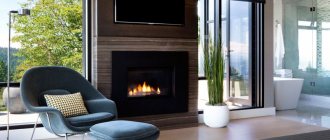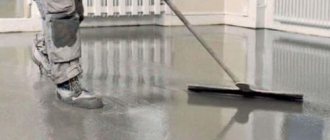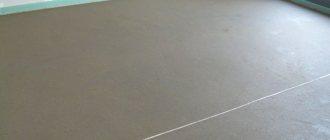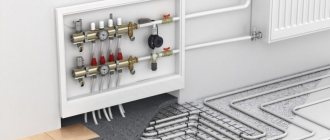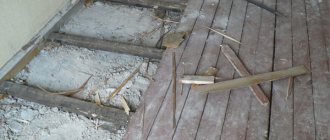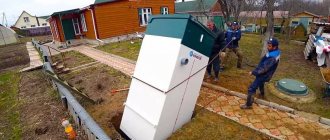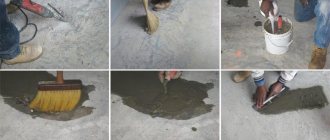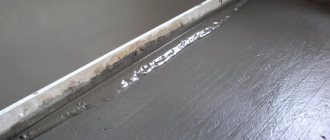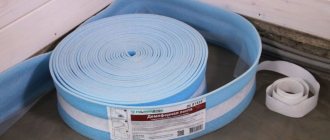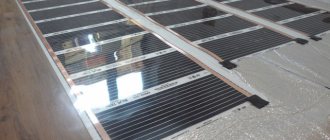Nowadays, in most cases, various screeds are prepared to level the base for the subsequent laying of finishing floor coverings. If several decades ago only concrete or cement-sand mortars were used for such purposes, today the list of materials and technologies that can be chosen to create a floor base is much wider. What types of screeds exist now? The answer to this question, as well as recommendations on which of the available technologies is better to choose in specific options, will be found in this article.
What should the screed be like?
Laying screed is the most common option for insulating and leveling the subfloor.
Modern flooring materials, or rather their laying technologies, impose certain requirements on the surface on which it is planned to lay the flooring. The screed must meet the following standards:
- the surface must be horizontal, flat and smooth (curvature of 0.2 mm per linear meter is allowed);
- the base of the floor must be strong;
- the screed must be thermally insulated;
- Waterproofing should be created if necessary.
Achieving a result that meets the requirements is done in various ways, that is, using various types of technologies.
Device requirements
All requirements for the device are specified in SNiP, which allows you to make a high-quality floor. The following criteria are adhered to in the question presented:
- The minimum thickness is 2 cm. The given value applies to rough and finishing coatings. If additional sound insulation is used along with water pipes, the thickness increases to 4 cm.
- The thickness should prevent any deformation. Otherwise, the finishing coating will collapse. Since the water floor requires the use of copper pipes, the top screed should be made thicker.
- The solution is made from cement and sand with the addition of PVA glue or plasticizer. The strength of the finished composition should be 25 MPa. The minimum value is 15 MPa. If the finishing layer is a polyurethane self-leveling floor, which is then simply painted, it is enough to make the mixture with a strength of 20 MPa.
To check the flatness of the coating, it is recommended to use a special level 2 m long. In this case, there may be unevenness of up to 2 mm if the finishing coating is parquet, laminate, linoleum or a self-leveling floor based on a polymer mixture. If other coatings are used, unevenness of 4 mm is allowed.
Attention ! The presence of recesses will not interfere with the further installation and operation of the finishing coating. If there is a “hump”, it is removed with a grinding machine or other method.
Types of screeds
An example of a semi-dry screed with expansion joints
In addition to classic cement mortars, which are also called wet, the following types of screeds are used today:
- semi-dry;
- dry;
- self-leveling.
The ultimate goals of all methods of leveling the subfloor are approximately the same, but the technologies differ, sometimes greatly. Types of screeds differ not only in the methods of their construction, but also in the final characteristics. The prepared bases differ in the following parameters:
- strength;
- weather resistance (the ability to maintain quality under the influence of moisture and temperature factors);
- surface quality;
- thermal conductivity.
Also, all types of screeds differ in the complexity of the installation process and the final cost of the complex material plus labor. Next, we will consider the peculiarities of creating each type of floor base, and the area of their priority application.
Warm floor
This question is not strange, since there can be two types of such ties:
- rough;
- screed that is poured over the pipes.
It is recommended to buy all materials for screeding a heated water floor in special stores where experienced consultants work. Here you can get advice not only about quality materials, but also find out how thick the screed should be and how much sand concrete is needed.
Warm floor
Before pouring, it is also important to consider some rules. The first step is to plaster the walls, and also, if this is a new apartment or house, be sure to install windows. Do not forget to carry out all communications, since the prepared base for this type of floor must be clean and completely level.
Please note the absence of various pebbles, as well as particles of sand or mortar. Next, before laying the insulation, remove all pieces of mortar, if any. Now attach the damper tape around the perimeter of the entire room.
Laying pipes requires, in most cases, the hands of craftsmen who have already carried out similar actions more than once.
What types of wet screeds are there?
An example of a concrete mortar containing crushed stone.
Cement-based liquid mortars also come in two types:
- concrete;
- cement-sand mixtures.
The second type of material for installing floor screeds differs from the first in that it does not contain coarse filler, crushed stone. Otherwise, the solutions are similar, but depending on the purpose, the proportions of fillers and binder components may vary.
Concrete is the most versatile material for constructing floor subfloors. It can be used inside and outside buildings, making rough and finishing screeds. For large-scale capital construction, concrete is indispensable and it is unlikely that an alternative will appear soon. This is due to the following advantages of the material:
- the ability to produce industrially in large volumes and deliver it to the site in finished form;
- concrete, due to its consistency, can be mechanically supplied in unlimited quantities to buildings of any height;
- pouring occurs very quickly with an uninterrupted supply of material;
- concrete is the cheapest solution, which plays an important role in large volumes of pouring;
- The concrete pouring layer is practically unlimited, which makes it possible to level the surface of any degree of curvature.
By changing the proportions of cement and fillers, you can prepare a concrete mixture of different grades, which is used depending on the expected operational loads. In this way, by reducing the percentage of cement, the material is made even cheaper. Classic concrete is also used in private construction. This is the material of choice when creating rough subfloors, both on a concrete slab and on the ground.
How to make a semi-dry floor screed with your own hands?
With the proper skill of the contractor, using concrete mortar it is quite possible to create a finishing screed with a surface that does not require additional leveling. However, now they prefer to use other materials for finishing layers, which will be discussed later. Concrete mortar is used to create the finishing surface in technical rooms and for outdoor work.
An example of a cement-sand mortar.
The classic mortar also has a number of disadvantages, which is why in many cases other materials are preferred to it:
- the need for reinforcement;
- long ripening;
- significant shrinkage and tendency to cracking;
- the need to control the moisture content of concrete during its maturation;
- the complexity of preparing concrete yourself;
- the difficulty of high-quality surface leveling;
- the need in many cases to additionally strengthen the top layer of the screed;
- cannot be poured in a thin layer (minimum 4 cm).
In addition, the concrete base of the floor is heavy and too thermally conductive, therefore it places a large load on the floor and in many cases requires insulation.
In some cases, concrete is replaced with a cement-sand mixture. It is better when you need to make a relatively thin layer of screed. However, a solution containing only sand as a filler requires a higher percentage of cement, is less durable, and therefore is used only inside residential premises, where there is little load on the floor surface.
Now the use of so-called lightweight concrete, which differs from the classic composition, is gaining popularity. Instead of heavy crushed stone, granules or expanded polystyrene foam are used as filler. This material is less durable, therefore it is only suitable for installing internal screeds, but it is better in that it provides insulation at the same time as leveling the base of the floor.
Important! Lightweight concrete based on polystyrene foam has a density of only 200-250 kg/m3. A ten-centimeter layer of polystyrene concrete will provide reliable thermal insulation of the floor in any region. In this case, the load on the floor is minimal.
Wet solutions also include ready-packed mixtures. They are used in the same way as other liquid cement compositions, but they form a more even surface and do not require reinforcement (they contain reinforcing fibers). The use of such materials is more expensive. They are best used for small-thick fills (up to 5 cm) when screeding is necessary in limited areas. For larger-scale work, it is better to use the following type of floor screed.
Materials used in work
To install a water heated floor, you can mix the materials yourself and get a solution of the desired consistency. To do this you need to prepare:
- sand with a fraction of 1.8-2.00 mm;
- Portland cement - categories no less than M-400;
- plasticizer - at the rate of 1 liter per 100 kg of cement used;
- polypropylene fiber - added to the desired consistency, up to approximately 900 g per batch;
- water in the right quantity.
The presented materials are kneaded until smooth so that there are no lumps. If the mixture does not work, it is recommended to use a mortar pump. The resulting composition is used for one and a half hours for its intended purpose, in accordance with the installation techniques for water-based underfloor heating.
This mixing method helps save money, and the resulting solution is not inferior to the properties of purchased ready-made compounds.
Semi-dry mixtures
For large areas, a machine method of installing a semi-dry screed is used.
This is, in fact, a slightly modified sand-cement mixture. It has a limited water content, which is why the working substance is moistened but crumbly. The lack of moisture is compensated by the addition of plasticizers and some other additives, which enhance the astringent properties of cement. Thanks to this, the strength of the finished base is higher than when using conventional concrete.
Leveling with semi-dry mixtures is now used everywhere. On large areas, the machine method of screeding is used, when almost all work processes are mechanized. On a small scale, a manual method of making screeds using semi-dry mixtures is used.
Working with such materials is done somewhat differently. The semi-dry mixture is laid in layers and compacted. When the level of the backfilled layer exceeds the horizontal line indicated by the beacons, the excess is removed by the rule and smoothed over with it. After a short time (1-2 hours), you can carefully walk on the screed. At this moment, the final smoothing of the surface is done with a metal trowel.
Floor screed - types and why it is needed
Compared with the wet method, the semi-dry method has a number of advantages:
- setting and final crystallization occur much faster;
- the laid layer is much denser, devoid of voids;
- there is no need to reinforce the material;
- There is very little shrinkage during ripening;
- the surface is stronger and does not require topping;
- the screed is flat, smooth, suitable for laying any floor covering;
- the cost of material and labor is almost identical to these indicators of the wet pouring method.
No disadvantages have yet been identified with the semi-dry method of screeding, so this technology can be called the best from the consumer’s point of view. However, building material manufacturers are developing new methods in an attempt to further optimize the process of creating a base for laying floor coverings. One of these technologies is the creation of a surface without the use of water.
Concrete
This option requires certain tools:
- Master OK
- knife;
- roulette;
- lighthouses;
- a drill with a special attachment, with which you can easily stir the solution;
- rule;
- putty knife;
- level;
- capacity.
A wet screed can easily be laid on the base, as well as on the waterproofing layer.
To prepare such a solution, you should properly mix the components: sand and cement in a ratio of 1:3.
In order to choose these elements correctly, when purchasing them, it is recommended to clarify which sand is best for floor screed.
Concrete
If the surface has very large differences, it is recommended to use a special metal mesh. To make the solution better, you can use plasticizers and fiber additives.
These elements prevent the appearance of cracks at the very base, but you need to know their consumption.
The entire floor should be pre-moistened with plain water. The process of pouring the solution should begin from the farthest corner of the room in which you are making the screed. You need to stretch the covering according to the rules - towards you and with inclinations to the right as well as to the left.
At the same time, do not forget to shake the mixture lightly, which will eliminate the possibility of bubbles appearing in the solution. If this does not work, you should pierce the mixture in several places using ordinary wire. Only after a day can you remove the beacons.
If you did not use such elements, but installed wooden blocks instead, you can leave them. This screed requires a lot of time to dry, which is approximately one month. During this period, the base must be periodically moistened with water, as a result of which the screed will dry evenly and not crack.
The solution can be prepared with your own hands or purchased in specialized stores. It is worth noting that in such stores you can consult with specialists regarding which M300 sand concrete is best for floor screed, as well as on other similar issues.
Ready-made mixtures are considered the best mixtures for floor screed.
Dry screed
This technology, which was first developed by Knauf specialists, is completely different from the usual perception of the process of installing a floor subfloor. This method of creating a base involves laying gypsum fiber boards on a previously leveled and compacted backfill. The sequence of work is as follows.
- Special slats are installed on the rough screed or floor slab in one plane. They serve as beacons.
- A layer of fine expanded clay is poured between the slats and carefully leveled to create a flat surface.
- Gypsum fiber plates with connecting elements are laid on the leveled bedding, which serves as a support cushion. The slabs are glued together and additionally fastened with self-tapping screws, forming a continuous hard surface on which any finishing flooring materials can be immediately laid.
An example of laying a dry screed along beacons.
A semi-dry screed turns out to be somewhat more expensive when compared with the technologies described above. The advantages of this screed method are the following:
- there is no technological break associated with the need to dry the surface, which is necessary with other methods, which greatly speeds up the work as a whole;
- laying slabs is not complicated and less labor-intensive;
- the surface turns out the way it should be, that is, it does not require additional leveling or strengthening.
However, there is a significant drawback in this method. The fact is that gypsum fiber board, which is the top layer of dry screed, is afraid of moisture. Therefore, in rooms with high humidity, such a base for floor coverings will not be suitable. Dry screeds are good for living rooms and office spaces. For damp places it is better to choose a cement-containing mixture.
Thickness under system
Before installing a water heated floor yourself, you should learn all the technology, including what thickness should be under the pipes. In this case, adhere to the following recommendations:
- It is necessary to lay out a rough fill under the pipes. It is carried out efficiently, since to correct errors the entire floor will have to be dismantled. Almost the entire load is placed on the roughing. The presence of errors leads to the destruction of the entire coating. There is heat loss, pipe breakage and destruction of the finish coating.
- You can make the composition for rough filling yourself. For this, sand, cement and plasticizer are used. You can purchase a ready-made bag of dry mixture.
- For rough finishing, a plasticizer is used at a rate of 1 liter per 100 kg of cement. If it is not available, it is enough to use PVA glue; a similar amount is required.
The screed should be laid under the pipes in a layer of 2.5-3 cm. You can do a little more if you plan to clutter the room, including an additional partition. But you should not make a layer more than 4 cm, or less than 2 cm. Otherwise, the laid floor will begin to break.
Self-leveling solutions
Such materials are sold in the form of packaged dry mixtures from which a working solution is prepared. The purpose of self-leveling mortars is to create a thin leveling layer on the concrete surface. The working mixture is poured onto the prepared surface and distributed over it. Due to its properties, the solution self-levels, that is, it forms an even horizontal plane. Thanks to special additives, this material quickly sets and becomes suitable for laying finishing floor coverings.
Important! It makes sense to choose such a material to create a flat surface only in cases where you need to bring an existing screed to an ideal state. The cost of self-leveling solutions, frankly, is quite high, so it is very expensive to form thick layers with such material.
